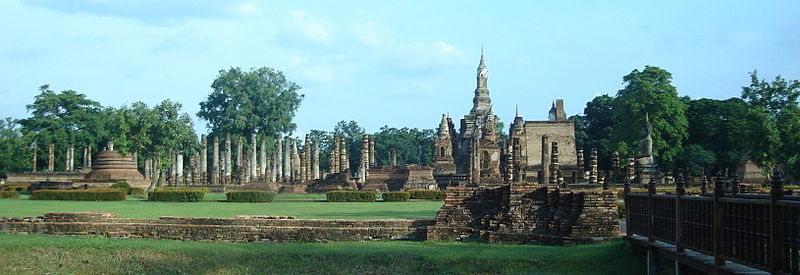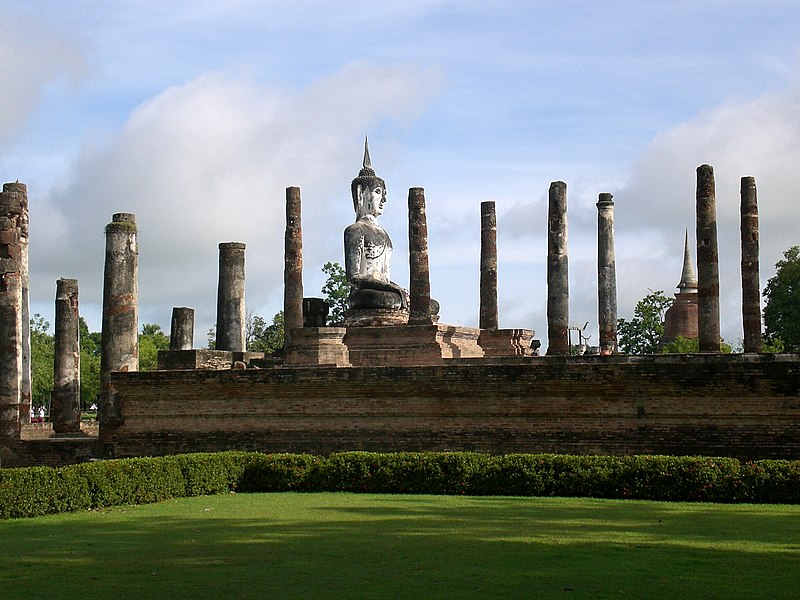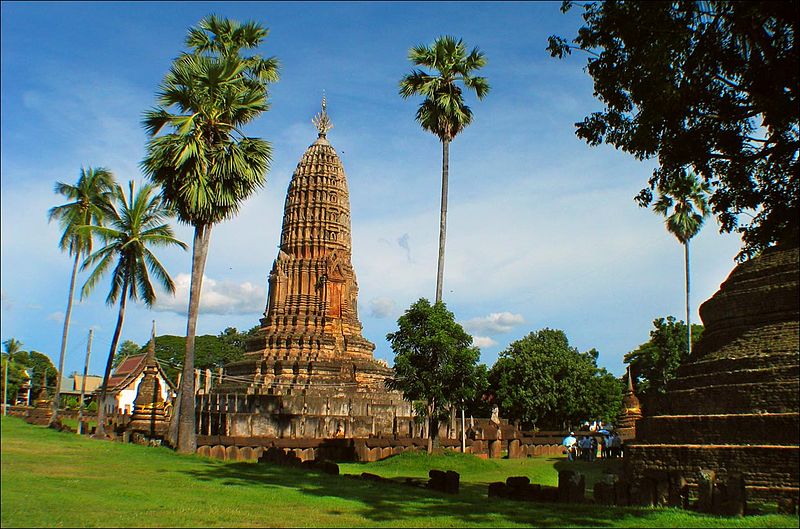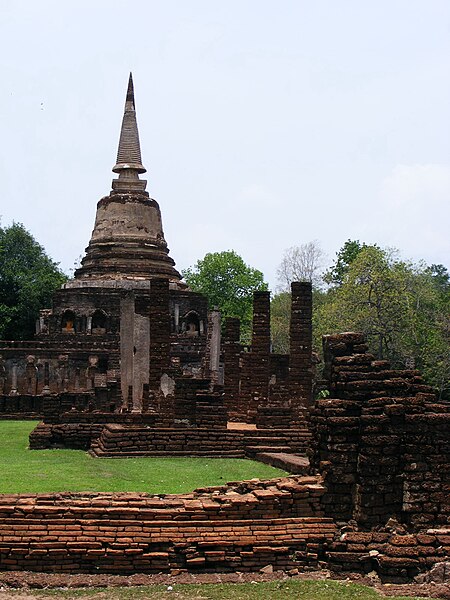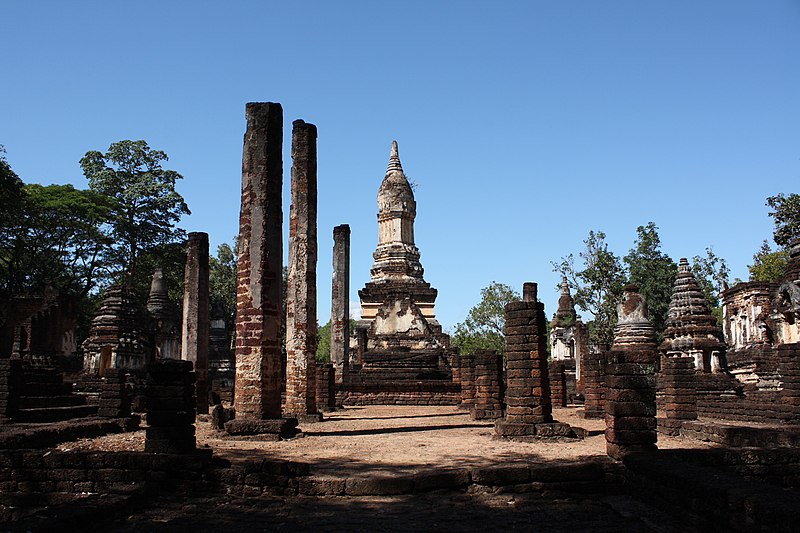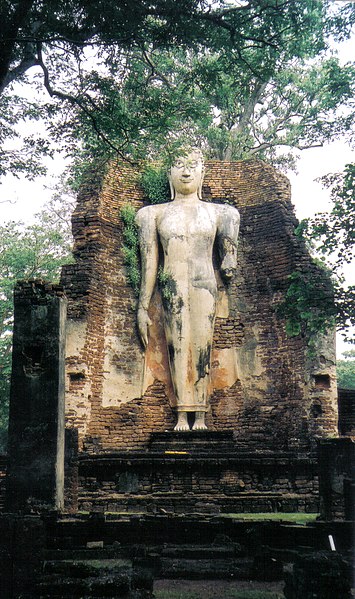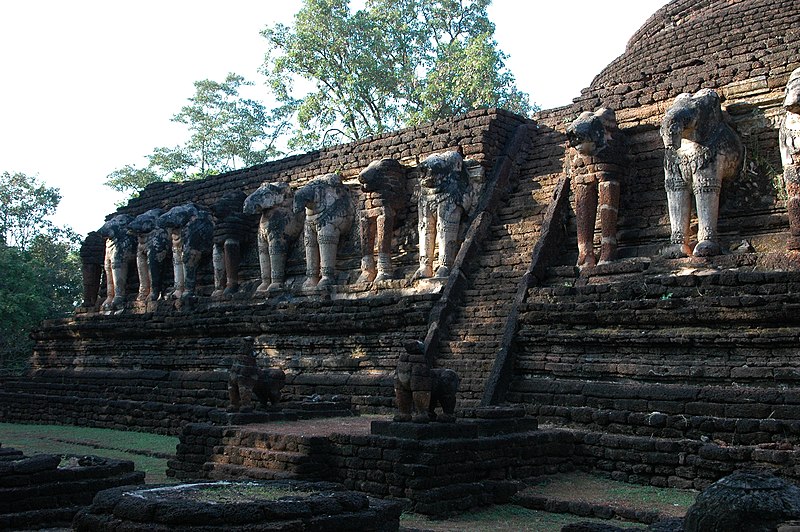The Historic Town of Sukhothai and Associated Historic Towns is a Unesco World Heritage site which consists of Sukhothai historical park, Kamphaeng Phet historical park and Sri Satchanalai historical park. These historical parks preserve the remains of the three main cities of the Sukhothai Kingdom which had flourished during the 13th and 14th century CE. The Sukhothai Kingdom is viewed as having been the first of the Thai kingdoms.
The Sukhothai Historical Park (Thai: อุทยานประวัติศาสตร์สุโขทัย) covers the ruins of Sukhothai, capital of the Sukhothai kingdom in the 13th and 14th centuries, in what is now the north of Thailand. It is located near the modern city of Sukhothai, capital of the province with the same name.
The city walls form a rectangle about 2 km east-west by 1.6 km north-south. There are 193 ruins on 70 square kilometers of land. There is a gate in the centre of each wall. Inside are the remains of the royal palace and twenty-six temples, the largest being Wat Mahathat. The park is maintained by the Fine Arts Department of Thailand with help from UNESCO, which has declared it a World Heritage Site. The park sees thousands of visitors each year, who marvel at the ancient Buddha figures, palace buildings and ruined temples. The park is easily toured by bicycle or even on foot.
The protection of the area was first announced in the Royal Gazette on June 6, 1962. In 1976 the restoration project was approved, and in July 1988 the park was officially opened. On December 12, 1991, it was declared a World Heritage Site as part of the Historic Town of Sukhothai and Associated Historic Towns together with the associated historic parks in Kamphaeng Phet and Sri Satchanalai.
History
Sukhothai was the first kingdom of Siam established some 800 years ago. The exact year is unknown but according to the Fine Arts Office it was between 1238 and 1257. Established in around 1238 to 1257, Sukhothai literally means “Dawn of Happiness”. Phokhun Si Intharathit was the founder of the Phra Ruang Dynasty, Sukhothai’s first Dynasty. For 120 years as the capital of Siam, Sukhothai was ruled by many kings. In this connection, the most dynamic monarch being King Ramkhamhaeng the Great, who created the Thai alphabet, laid the foundation for politics, monarchy, and religion, as well as, expanded its boundary of influence. Though the golden era of Sukhothai no longer exists, tourists should bear in mind that respect and admiration for the renowned ruined twin cities of Sukhothai and Sri Satchanalai is valued.
Sukhothai historical park covers a total area of 70 square kilometers. It comprises of hundreds of historic sites located both inside the old city wall and also spreading out beyond the wall within a radius of approximately 5 kilometers. It might possible to take several days, up to a week, to cover all historic temples, but for those who have limited time, then just visiting some of those among the top of the list of “must see sites” should be very rewarding.
Arriving inside the historic town of Sukhothai, the first and most important site to see, which is never skipped by visitors, is Wat Mahathat temple. Being the heart of Sukhothai’s religious area, Wat Mahathat was built in accordance with the ancient Indian concept of Mandala by the first king of Sukhothai Kingdom, King Sri Indrathit. The large compound of this significant temple comprises of 200 chedis – with the main one in the center, surrounded by 8 mini chedis, and has the elegant shape of a “lotus bud” characterizing the authentic art originating from Sukhothai. The chedis with lotus bud shapes can also be found at Wat Tra Phang Ngoen (located inside the old town) and at a few other temples located outside the town’s wall.
The numerous amounts of chedis found in the historical park can be roughly categorized into three different styles.
The first style is of an authentic Sukhothai style known as the lotus bud shaped chedi, while the other two styles were influenced by foreign kingdoms; Khmer and Lanka. Before the establishment of Sukhothai, the area was influenced by Khmer art and culture, of which the evidence is seen in many Hindu temples which have been transformed into Buddhist temples during Sukhothai period, but with a Khmer architectural style of the main stupa called “Prang” remaining unchanged. Another style of chedi is found in Sukhothai – this is the “bell shaped” chedi influenced by Lankan art and which later became the general style of Buddhist chedi throughout the kingdom.
Next to Wat Mahathat is Wat Chana Songkram previously known as Wat Ratchaburana, the ancient temple with a big presidential chedi of a rounded bell shape and many smaller chedis and vihara create a beautiful layout. Adjacent to the east of Wat Mahathat, there is another interesting ruin called Noen Prasat Phra Ruang which is, according to the assumption of King Rama VI, the remains of the base of the Sukhothai royal palace. However, after the excavation of the site by the Fine Arts Department in 1983, there was no evidence found to support that original assumption. It was more likely to have been a religious building or a pavilion, as it is now believed that the palace was actually made of wood and would have been situated somewhere else – according to the similar layout of Khmer palace in Angkor Thom.
Another temple inside the wall of the old city is Wat Tra Phang Ngoen, located to the west of Wat Mahathat. The most significant highlight of this temple is its main chedi, resembling a lotus bud with four niches to enshrine standing or walking Buddhist images, which is what makes the chedi of this temple different to other lotus bud chedis found elsewhere. A vihara and an uposatha(the ordination hall) in the middle of a reservoir also boasts some outstanding features and is another “must visit” of this ancient site.
Nearby a corner of the historical compound, located Wat Sasi which is one of the most important historical sites in the old town of Sukhothai. It was built elegantly in the middle of a large reservoir known as Tra Phang Tra Kuan and composed with the main bell-shaped chedi of Lankan style, a beautiful Buddha image enshired in front of the vihara, and the ubosot or ordination hall situated in the islet in the middle of a lake. Without doubt, Wat Sasi is one of the stunning viewpoints in the historical park.
Next historical place, Wat Sri Sawai, which was originally a hindu sanctuary, but was later transformed into a Buddhist temple with a vihara added in the frontal part of the three “prangs” (the ogival towers as seen in the Angkorian temple) originally built in traditional Lopburi style which was influenced by Khmer art. The main visible evidence that proves this place to be a former Hindu temple is a carved lintel depicting the reclining Vishnu on Ananta Naga (Anantasayana) found at this historical site.
In the outer areas of Sukhothai, Wat Phra Phai Luang, which is the second most important temple built before the foundation of the Sukhothai Kingdom and was also the center of the first settlement. The most interesting spot is the three prangs of Bayon, styled during the reign of the Khmer King Jayavarman VII.
 A bit further on is the location of Wat Si Chum, the ancient monument which is a highlighted destination and also the symbol of Sukhothai’s tourism, well known for a huge “sitting-posture” Buddha image named “Phra Achana” which is carved in the attitude of subduing Mara, spanning an impressive width of 11.30 meters. Phra Achana is enshrined in the chapel hall, with its walls as thick as 3 meters. On one side of the wall is a recess where a stone inscription details the founding of the Sukhothai dynasty and on its ceiling it is decorated with more than 50 pictures carved into the stone, telling stories of former incarnations of Lord Buddha (Jataka) accompanied by captions for each picture written in the Sukhothai alphabet.
A bit further on is the location of Wat Si Chum, the ancient monument which is a highlighted destination and also the symbol of Sukhothai’s tourism, well known for a huge “sitting-posture” Buddha image named “Phra Achana” which is carved in the attitude of subduing Mara, spanning an impressive width of 11.30 meters. Phra Achana is enshrined in the chapel hall, with its walls as thick as 3 meters. On one side of the wall is a recess where a stone inscription details the founding of the Sukhothai dynasty and on its ceiling it is decorated with more than 50 pictures carved into the stone, telling stories of former incarnations of Lord Buddha (Jataka) accompanied by captions for each picture written in the Sukhothai alphabet. Another temple, Wat Saphan Hin, located on a small hilltop of 200 meters. So, to reach the upper yard of the sanctuary it takes a little bit more energy to follow the slate staircase, but the effort will be fully repaid with a great view of the plain and an “upright posture” Buddha image watching over the surrounding areas, standing tall at 12.5 meters.
Another temple, Wat Saphan Hin, located on a small hilltop of 200 meters. So, to reach the upper yard of the sanctuary it takes a little bit more energy to follow the slate staircase, but the effort will be fully repaid with a great view of the plain and an “upright posture” Buddha image watching over the surrounding areas, standing tall at 12.5 meters.If it is not so much cloudy, so you have a change to view the sunset behind Wat Mahathat. However the sky during the twilight, orange tints and rays of light bursting in between the clouds illuminated the chedis and images of Buddha, producing a breathtaking scene of this historically spiritual site. It will be an unforgettable dusk with a magical brilliance that briefly takes you back to the previous glory of the Sukhothai Kingdom.
Source: http://en.wikipedia.org/wiki/Sukhothai_historic_park
Images: http://commons.wikimedia.org/wiki/Category:Sukhothai_historical_park



